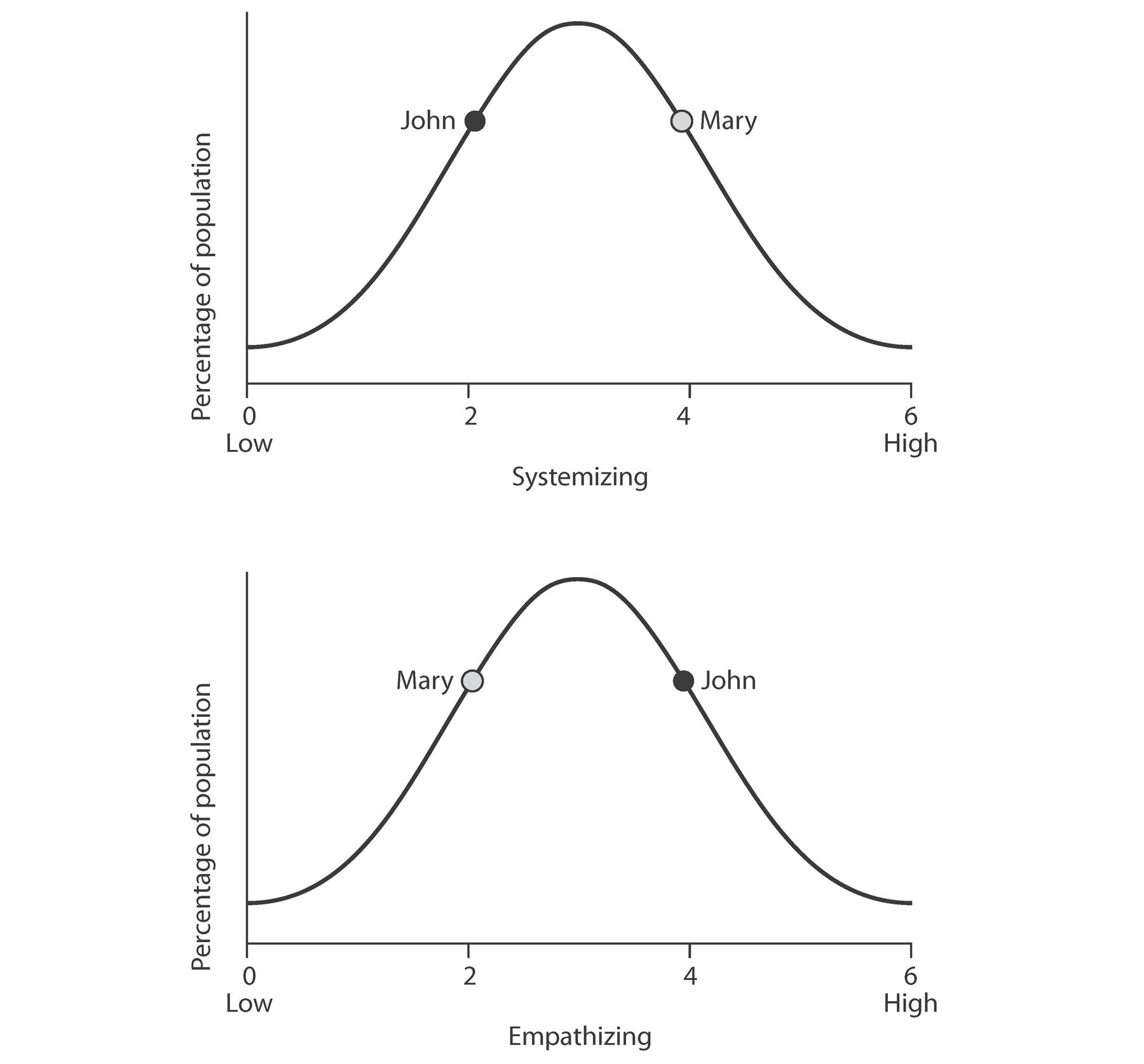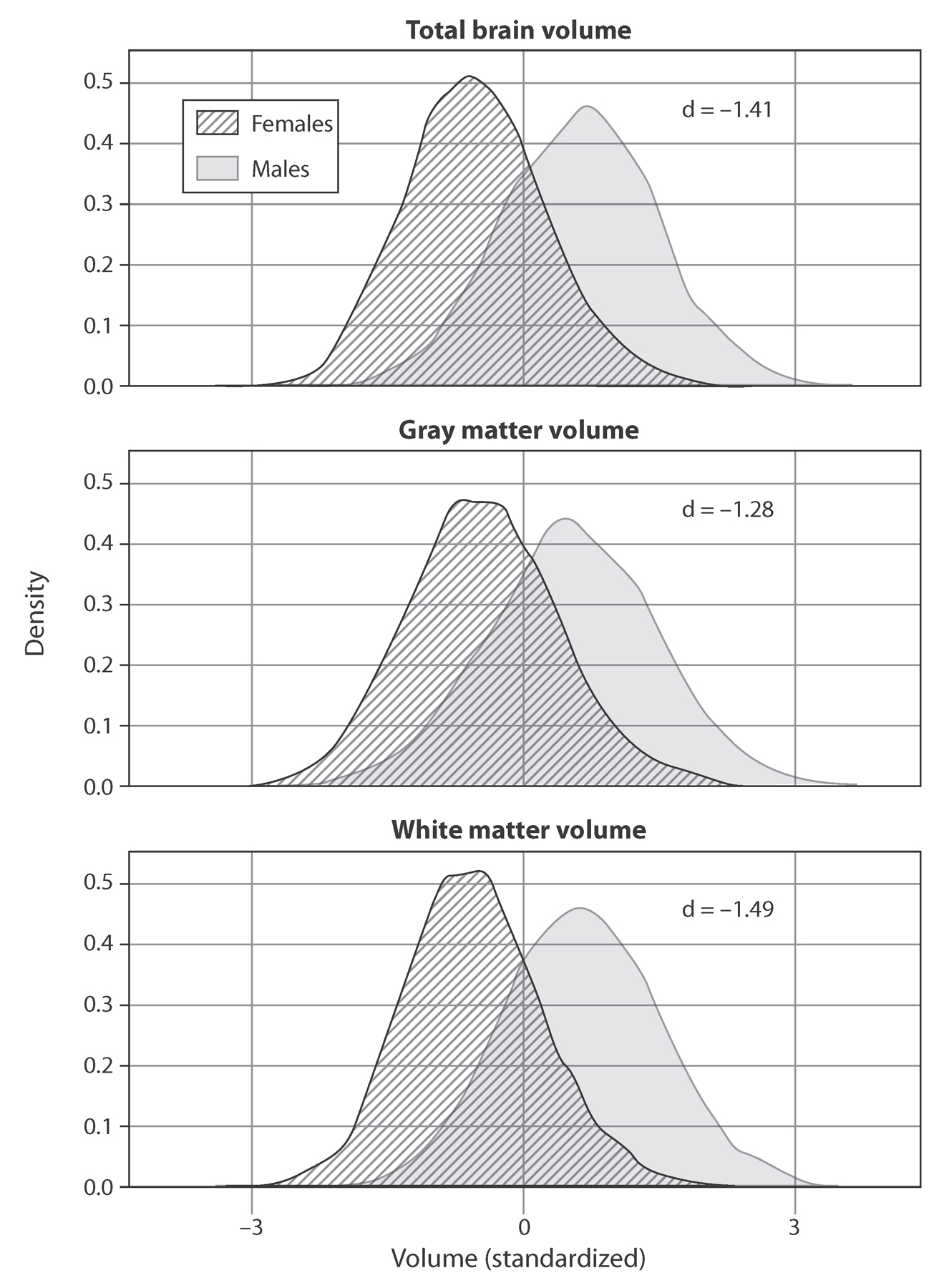Chapter 3
Five Types of Brain
The UK Brain Types Study was an ambitious attempt to measure 600,000 people in terms of their empathy and their systemizing.1 In this huge study, the first of its kind, we asked people to fill in brief versions of two questionnaires: the Systemizing Quotient (SQ) and the Empathy Quotient (EQ). (These are available in Appendix 1 if you want to find out how you score.)
The SQ asks about your level of interest in systems: these are as varied as map reading, music, knitting, grammatical rules, bicycle mechanics, cooking, medicine, genealogy, train timetables, and public health.2 All of these systems follow if-and-then rules. If you score high on the SQ, you are the kind of person who pays a lot of attention to detail, such as the small print in legal contracts, or the specifications of your computer or car engine. You might also be a collector of a niche category of objects, like coins, stamps, or butterflies, and you might like to keep an ordered (systematic) list of your top ten favorite songs or films (even if it’s just in your head). Those who fall super-high on the systemizing bell curve are those who also have a strong drive to invent, and we can assume that, across human evolution, they always did.
In contrast, the EQ measures how easily you find it to imagine what another person might be thinking or feeling. As we discussed in the last chapter, cognitive empathy is the ability to imagine another mind, particularly what another person, animal, or any other kind of being (even a god) might believe, know, desire, perceive, or feel. This is the capacity that allows humans to engage in flexible deception, flexible communication, teaching, cooperation around shared beliefs, and even spirituality. These two measures, the EQ and the SQ, tap into the two revolutionary mechanisms in the evolution of the human brain.
The first thing we found in the UK Brain Types Study was that both empathy and systemizing fall on bell curves in the population. We are all located somewhere on each of these bell curves. A bell curve tells us that a trait lies on a continuum rather than being binary. A bell curve can also be a clue that a trait could be partly polygenic (meaning the trait could be partly influenced by hundreds or thousands of genes). Undoubtedly social learning also plays a role in empathy and systemizing, but the bell curves give us a clue that we should look for possible multiple genetic factors underlying these too.3
We then looked at five different brain types. The first group consisted of people who are equally good at both empathizing and systemizing. We called them Type B, for balanced. The second group comprised people who are high on empathy and low on systemizing. We called them Type E, because they are naturally drawn to empathize with people but less interested in systemizing to see how things work. In the third group were people who are the opposite: high on systemizing and low on empathy. We called them Type S, because they are naturally drawn to systemize but less interested in empathizing.
Figure 3.1. The systemizing and empathy bell curves. Mary, an engineer, is high on systemizing and lower on empathy. She is a hyper-systemizer. John, a therapist, has the reverse profile. He is high on empathy but lower on systemizing. He is a hyper-empathizer.
Finally, we looked at two extreme brain types: Extreme Type E, those who are super-high on empathy but below average on systemizing, and their polar opposite, Extreme Type S, those who are super-high on systemizing but below average on empathy. Jonah and Al, whom you met in chapter 1, are both Extreme Type S.
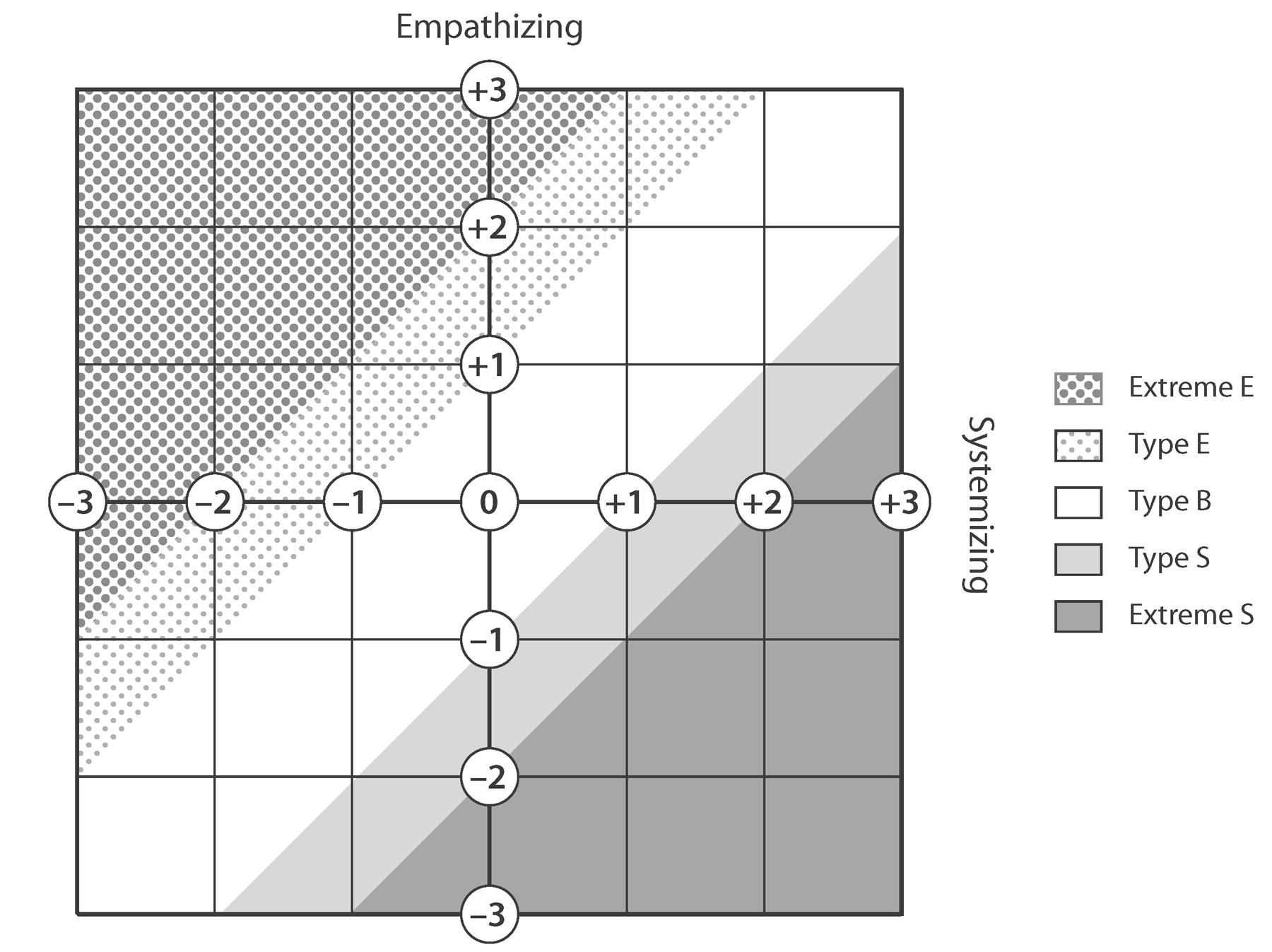
Figure 3.2. The five “brain types”
These five brain types are examples of neurodiversity—the varieties of brains we find in any school classroom or in any workplace, like the varieties of flowers or animals in nature.4 None is better or worse than another; they are all just different, and each evolved to thrive in different environments. Which brain type you have depends on the tuning of the Empathy
Circuit and the Systemizing Mechanism, which in turn determines where you are on the empathy and systemizing bell curves. To give you a feel of the different brain types, which are defined by the difference between your levels of empathy and your systemizing, let’s explore them in a bit more detail.
TYPE E
These are individuals whose empathy is higher than their systemizing. About a third of the population is Type E, and this brain type is about twice as common in women (40 percent of women) as in men (24 percent of men). Those with Type E brains are very comfortable with people, chatting easily, seeing the dynamics in relationships, and easily able to tune into how others are feeling, and they are likely to gravitate toward jobs in the caring professions, such as counseling or charity work. Compared to individuals who have Extreme Type E brains, they are somewhat less focused on empathy all the time—they make time for themselves as well as for others.
In terms of their systemizing, people with Type E brains can see new patterns when these are pointed out, but this doesn’t come naturally to them. They can use technology when they need to but are not passionate about it. If shown a function in a device, they can follow the instructions given to them, but they would struggle to discover how to repeat the operation if they forgot it or if they had to work out how to do it for themselves. They use technology at a basic level, but do not master it. They enjoy getting to know one system or simple device if it makes life easier, but they still find more complex technology challenging. In contrast, they empathize intuitively.
TYPE B
Individuals who are Type B show no difference between their empathy and their systemizing, which is why they are called “balanced.” They comprise roughly another third of the population and are as common among men (31 percent of all men) as among women (30 percent of all women). They are equally good, or equally challenged, at using empathy or systemizing. They are as good at communication as they are at using technology.
TYPE S
The mirror opposite of Type E, people who are Type S, are better at systemizing than at empathizing. They comprise roughly another third of the population. Type S is about twice as common in men as in women (40 percent of men and 26 percent of women). They are good at navigating their way through systems and seeing patterns in how systems operate. Without needing a manual, they can pick up a device and understand it, confidently and quickly, through trial and error. They are willing to “have a go,” to experiment to find out how things work.
These are the people who are the first to jump in to volunteer to try to fix something when it breaks, in any situation—a classroom or the workplace, at a barbeque or on a camping trip. Type S individuals are also happy to teach others how to use technology. They may not be inventors of technology, but they are very useful to have around. They gravitate toward the exact sciences or the STEM fields, and to music, architecture, and other analytic fields (law, linguistics, accountancy, philosophy, and proofreading), as well as crafts, sport, nature (including gardening), and cooking. These are all endeavors where searching for if-and-then patterns is a main focus. They also gravitate toward special environments where they can analyze the effects of changing one variable at a time, for example, laboratories, mechanical workshops, music, art or film studios, business, kitchens, or gardens. Some even use their if-and-then thinking to construct fantastic novels or dramas with elaborate plots, or to construct stories or arguments in a legal case. In their everyday lives, they also prefer to do just one thing at a time. They like systems, so their lives are more orderly and routine. They dislike trying to follow a conversation when several people are talking at once. As regards their empathy, they can get by, but find empathizing an effort rather than something that feels either intuitive, easy, or fun.
EXTREME TYPE E
People with this brain type have very strong empathy but are below average on systemizing. People who are Extreme Type E are rare in the population, and this brain type is more common in women than in men (3 percent of women but only 1 percent of men). These individuals are hyper-empathizers. They empathize effortlessly and intuitively because their Empathy Circuit is tuned super-high. They are quick to anticipate what someone will feel or think, and what’s best to say or not say in a conversation. They can chat effortlessly, even if there are multiple conversations going on at once. They quickly notice if someone is feeling awkward or upset, often before anyone else does, and are always thinking ahead as to what would be nice to do for another person. They stay in touch with their friends because other people’s changing situations are always on their radar.
But in terms of their systemizing, they barely notice patterns. They leave other people to operate technology for them because their Systemizing Mechanism is tuned pretty low. These individuals, given a new gadget, might get it out of the box, perhaps learn one or two basic functions, but rarely experiment to explore its potential. They can notice easy patterns (like multiplication tables, or rhymes to remember how many days are in a given month), but they struggle to understand more complex patterns. And at school, they tend to avoid subjects like mathematics. Because their mind isn’t looking for repeating patterns, it’s easy for them to “switch gears” when things happen unexpectedly. It just doesn’t bother them. Their natural way of thinking is to be empathizing non-stop.
EXTREME TYPE S
At the other extreme are individuals who, like Jonah and Al, are very strong at systemizing but below average on empathy. Like Extreme Type E, this brain type is also quite rare in the population. Extreme Type S is the mirror image of Extreme Type E in being twice as common in men (4 percent of men) as in women (2 percent of women). They are hyper-systemizers because their minds are wired to seek out patterns all the time, and they include autistic people.
Individuals like this can spot complex patterns such as: “if in a leap year the days in a given month fall on specific days of the week, and you look twenty-eight years ahead, then the days in a given month will fall on the same specific days of the week as twenty-eight years earlier.” Or they may choose bell ringing (campanology) as a hobby, because of the mathematical patterns involved.
Spotting such regularities in a system may mean someone who is Extreme Type S can say immediately on which day of the week any date in the past or the future will fall. Such individuals are called “calendrical calculators,” a form of “savantism.” Savantism is when a person has one area of skill that is not only way above their other skills but is also way above most people in the general population. (Some estimates of savantism are one in a million in the general population but one in two hundred autistic people).5 So, savantism is much more common among autistic people, and autistic people are more likely to be either Type S or Extreme Type S. Those who are Extreme Type S are also more likely to be autistic. People who are Extreme Type S are good at spotting deviations or inconsistencies in a system, at checking errors, and at fixing problems to make the system more efficient.
In terms of their social skills, because their empathy is below average, people who are Extreme Type S are often a bit too blunt in their communication, blurting out what they think or what’s on their mind without necessarily considering the impact of their words, not sugaring the pill, and they may not see anything wrong with what they’re saying or how they’re saying it, defending it as factual. They struggle to make or keep friends, and their challenges with empathy may leave them vulnerable to exploitation by others—they just don’t see the trap they are walking into. They are also at risk of feeling depressed after a long period of feeling socially excluded, despite their repeated attempts to try to fit in and to socialize with others. They may also mostly prefer their own company to that of others.
If you want to find out which brain type you have, just take the EQ and the SQ in appendix 1, which has a table to look up your brain type. You can also go online to find out at www.yourbraintype.com.

It’s interesting that most people in the population are not Type B—that is, equally good at both empathy and systemizing—when one would have expected this to be the optimal brain type. So why are only a third of people Type B?
In part this reflects how we have defined the brain types statistically to show us different percentiles in the population: Type B individuals are defined as those who fall between the 35th and the 65th percentile. But the fact that the majority of the population (two-thirds) are specialized to be either an empathizer (Type E) or a systemizer (Type S) may also be a clue that these brain types evolved under the pressure of natural selection, with some survival advantages to having a brain that was specialized. That would make sense if empathizers do well in one environment (the world of people, intuitively knowing what others may think or feel) and if systemizers do well in a different environment (the world of objects, figuring out how things work).
And why are only a small fraction of the population, about 3 percent, hyper-systemizers (Extreme Type S)? If, as I argue, being a hyper-systemizer is a prerequisite for the capacity for human invention, wouldn’t you imagine that natural selection would have favored individuals with this brain type? Shouldn’t they be far more numerous?
Again, a mundane statistical reason there are relatively few individuals with Extreme Type S brains is that we defined this brain type as those falling in the 2.5th percentile. But this may also reflect that there was negative selection pressure on individuals with this brain type. Perhaps as well as conferring remarkable advantages in spotting if-and-then patterns this brain type also carries certain disadvantages, namely, being challenged socially. This would be expected if the tuning of the Empathy Circuit and the Systemizing Mechanism is a zero-sum game.6 That is, the higher one of these is tuned, the lower the other is tuned. We’ll come back to look at evidence for this relationship between these two brain circuits.
Let’s have a closer look at hyper-systemizers, who, according to my theory, are central to the story of human invention because they systemize non-stop. Over the last 70,000 to 100,000 years, we can assume that hyper-systemizers were the individuals who could make a new musical instrument (such as a flute), identify a new food (such as cultivating rice), develop a useful new skill (such as navigating by the stars), or create a new tool (an aqueduct, for instance). We can make this assumption because, when we look at modern inventors, many of them show the hyper-systemizing profile.

Do hyper-systemizers share the same kind of mind as autistic people? To answer this question, we went back to the UK Brain Types Study. Over 36,000 autistic people took part in this study, the largest ever psychological study of autism. We found that a disproportionate number of autistic people had a Type S or an Extreme Type S brain. Indeed, 62 percent of autistic males showed one of these two brain types, a higher percentage than the 44 percent of typical males with these profiles. And 50 percent of autistic females showed one of these two brain types, a proportion twice as high as that seen in typical females (27 percent). These results fit with the idea that the autistic mind and the hyper-systemizing mind have something in common.
As an aside, these results also fit with a different idea, that autistic people have a more “masculinized” profile, that is, they show the Type S or Extreme Type S brain types that are more common in typical males in the population and where their systemizing is higher than their empathy. You can see this shift very clearly in their D-scores, which are a measure of the differences between one’s empathy and one’s systemizing (see figure 3.3).
A further clue that autistic people and hyper-systemizers share a similar type of mind comes from a study in which we gave autistic young teenagers a mechanical reasoning test where they had to figure out how a novel system worked. The test was originally designed to identify adults with the potential to study engineering. Autistic teenagers consistently outperformed typical teenagers on these tests.7
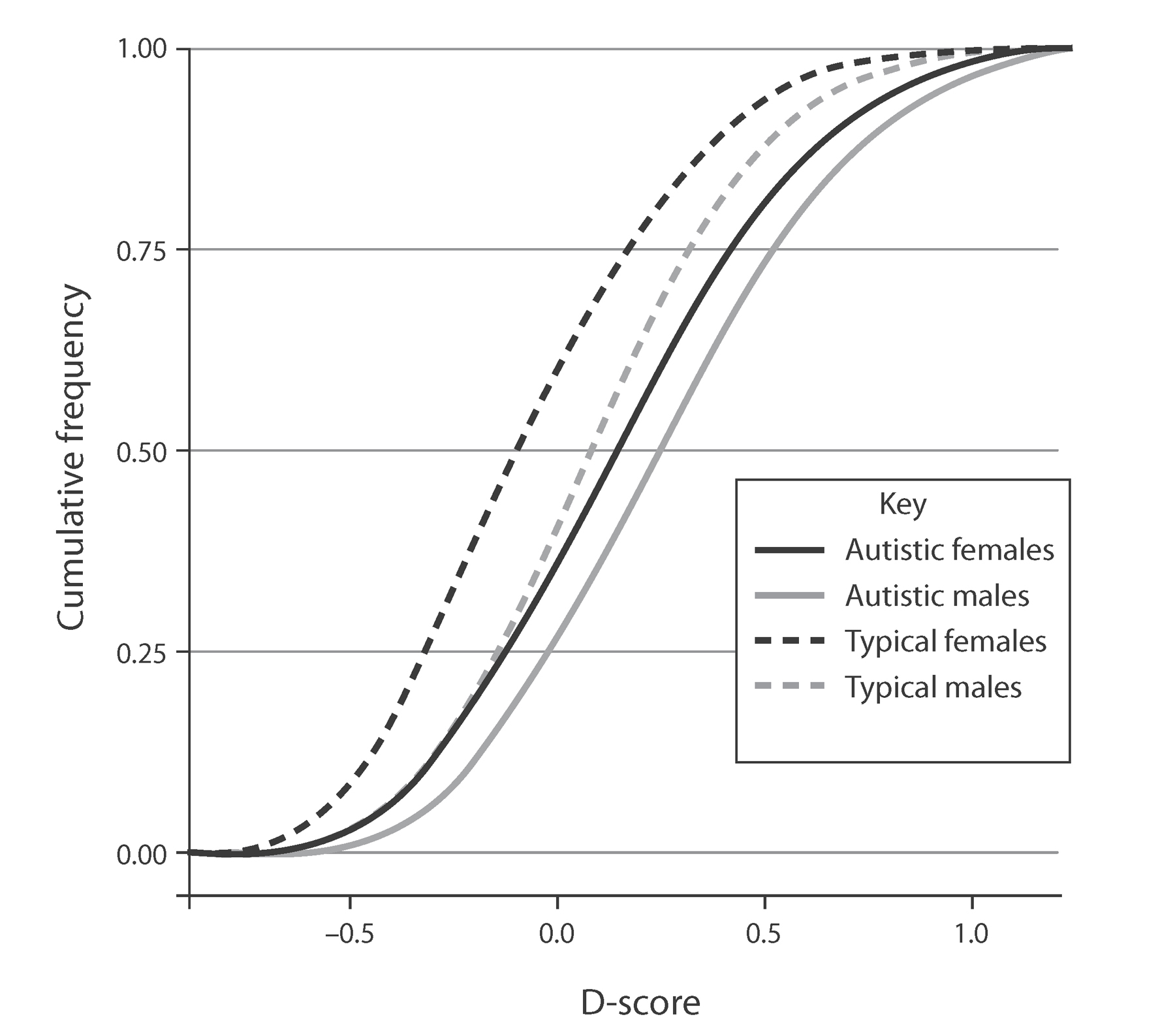
Figure 3.3. Your D-score is the difference between how much higher your systemizing score is relative to your empathy score. Typical males (dashed gray line) have a higher D-score than do typical females (dashed black line). Autistic females (solid black line) and autistic males (solid gray line) have extreme D-scores.
And there are more clues that this is the case. Psychologist Laurent Mottron found that autistic people were 40 percent faster than typical individuals at pattern detection using a nonverbal visual intelligence test, and that they showed more activity in visual areas of the brain while achieving this. And a study conducted in Silicon Valley in 2013 found that more autistic students were studying a STEM subject at university, compared to any other disability group, again suggesting that autistic people have hyper-systemizing minds.8 This was demonstrated back in 1972 by psychologist Uta Frith in her finding of superior pattern production by autistic children, even in those with a learning disability.9

Figure 3.4. An example from the mechanical reasoning test
Here’s a second question: Do systemizers (people with a Type S brain) and hyper-systemizers (those who are Extreme Type S) have more autistic traits? In the Cambridge University Autistic Traits Study, we asked over 1,000 students to take the Autism Spectrum Quotient (AQ).10 (Everyone has some autistic traits on the AQ, but some of us have more traits than others, and autistic people have very high scores on the AQ. If you want to see how many autistic traits you have, you can take the AQ in appendix 2.) We found that students in STEM disciplines had more autistic traits than students in the humanities. And we found that math students were more likely to have a diagnosis of autism, compared to students in the humanities.11
To extend this, we conducted the Big AQ Study, in which half a million people worldwide took the test—at the time, the largest study of autistic traits on the planet. Sure enough, we found that those working in STEM scored higher on the AQ compared to those working in non-STEM occupations. And we confirmed this in the UK Brain Types Study, this time with 600,000 people.12 Not only were those in STEM more likely to be Type S or Extreme Type S, compared to those in non-STEM occupations, but those in STEM occupations on average also had a higher AQ. In the UK Brain Types Study, we also found that people who were Type S or Extreme Type S had a higher score on the AQ.
This nailed it for us. Those with autism and those who are strong systemizers have similar minds.

Let’s return to the idea that systemizing and empathizing can be a zero-sum game: the more you have of one capacity, the less you have of the other. If this is the case, we should expect to see a trade-off, a negative correlation between empathy and systemizing: the better you are at one, the worse you are at the other. The results from the UK Brain Types Study did show a small trade-off.13 This suggests that, while these two dimensions are largely independent of each other, they may also share a common biological factor. But what could that be?
The biological factor might be expected to be a molecule that differs in quantity between the two sexes. That’s because we found three times as many females as males among those who were Extreme Type E, and twice as many males as females among those who were Extreme Type S. One such candidate biological factor is the amount of the hormone testosterone that a fetus’s brain is exposed to in the womb.14 Male fetuses produce at least twice as much of this hormone as female fetuses do during prenatal life, when the brain is developing, and animal research shows how this hormone changes (or “masculinizes”) the brain.
Talking about a more masculine brain, in humans, is controversial; some people want to deny that there are any sex differences on average in the human brain.15 But there is now no longer any question that there are some key sex differences on average in human brain structure, and these emerge when large-scale brain scanning is conducted. One convincing set of data to illustrate this comes from the UK Biobank (see figure 3.5).
There are also sex differences on average in the number of neurons that males and females have, as counted in postmortem studies of the brain. (Females on average have 19.3 billion neurons, while males on average have 22.8 billion. See figure 3.6.) And several of these average sex differences have been demonstrated at birth, suggesting that, whatever the role of culture later, a prenatal biological factor is also involved.16
So, could one reason why there are more females who have Type E brains and more males who have Type S brains be that males are exposed to higher levels of testosterone in the womb? We set out to test if prenatal testosterone shapes brain type, through the UK Prenatal Testosterone Study.17 This study followed six hundred babies in the United Kingdom from the womb into their teens. We measured their testosterone levels before they were born, to see if this predicted their later empathy and systemizing levels. We were able to make these measurements because all of the babies had mothers who had opted, for clinical reasons, to have an amniocentesis test. This is where doctors use a long needle to extract some of the amniotic fluid surrounding the fetus, to check for fetal anomalies. This gave us an opportunity to measure levels of prenatal testosterone in the amniotic fluid.
Figure 3.5. Average sex differences in gray matter, white matter, and total brain volume, in the adult brain of over 5,000 individuals. Hatched gray = females; solid gray = males. All of these average sex differences are significant after controlling for total brain volume, total surface area, average cortical thickness, and height.
Prenatal testosterone (and prenatal estrogen, the hormone that testosterone is converted into) has long been proposed as one driver of the differences seen on average in the brains of males and females, based on more than half a century of animal research where the amount of prenatal testosterone or estrogen the animal is exposed to is experimentally manipulated. Such experimental manipulations would of course be unethical in humans, but the UK Prenatal Testosterone Study gave us the opportunity to observe the correlations between prenatal amniotic hormone levels and the child’s later behavior.
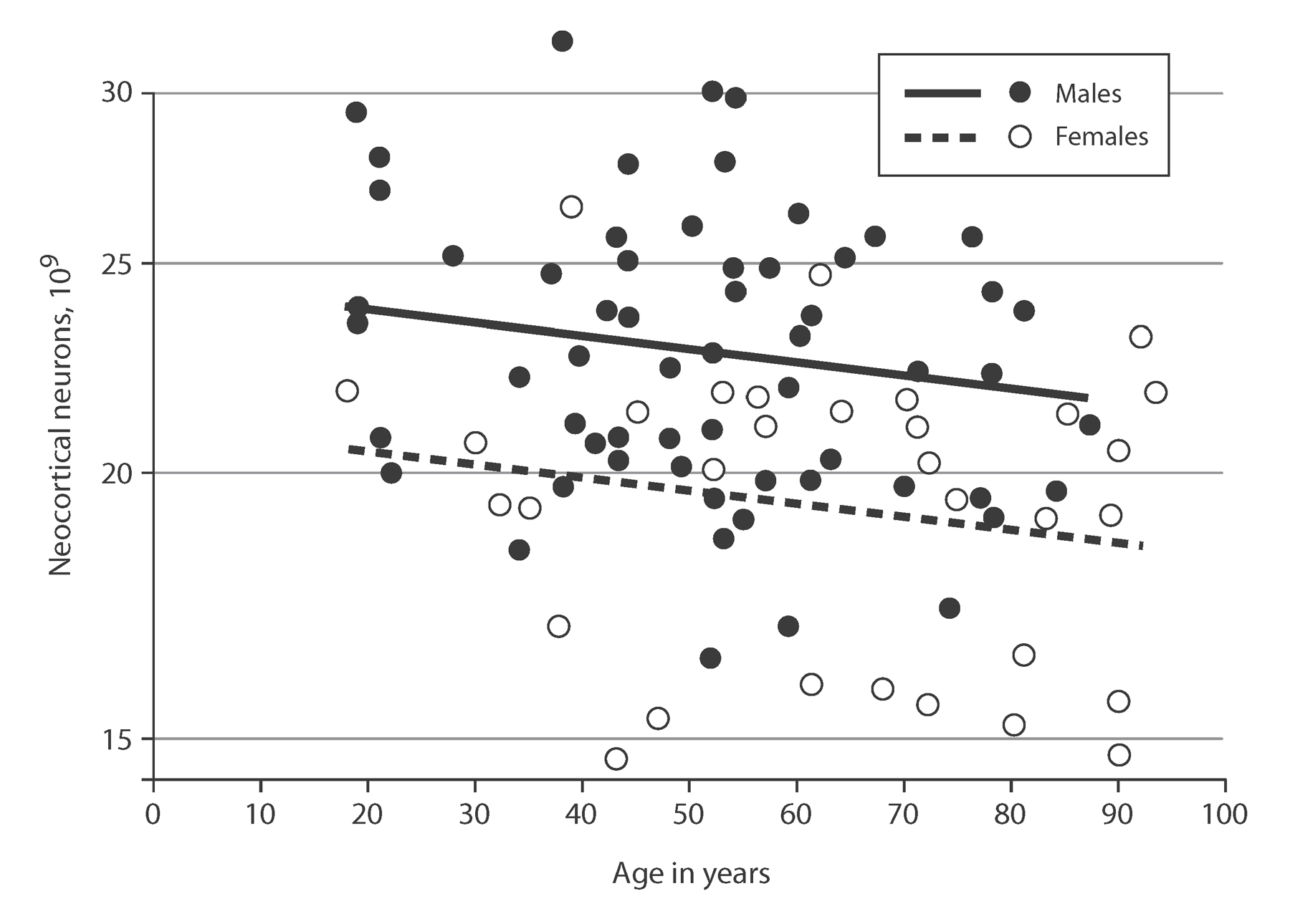
Figure 3.6. Average number of nerve cells in males and females in the cortex of the brain
As hypothesized, we discovered that a baby’s prenatal testosterone level predicts if they will end up being more Type E or Type S, independent of their gender. The mothers completed questionnaires about their child at age four, and we found that the higher the baby’s prenatal testosterone, the higher the child scored on the SQ and the lower they scored on the EQ. We also found that the higher the baby’s prenatal testosterone, the higher they scored when we followed them up at age eight on an attention-to-detail (systemizing) test and the lower they scored on the “Reading the Mind in the Eyes” (empathy) test.18
This was remarkable: testosterone levels in the womb were associated with both systemizing and empathizing, but in opposite directions. Prenatal testosterone was a biological factor that could partly explain why brains ended up leaning either toward Type E or toward Type S. And when we examined MRI scans of these children’s brains, we found that prenatal testosterone levels were indeed positively correlated with some brain regions (like the superior temporal sulcus, a region tuned to detect where someone is looking) and negatively correlated with others (like the planum temporale, a region involved in language).19 How much prenatal testosterone a child was exposed to in the womb is one of the factors associated with how fast they develop speech, and it is well established that girls on average develop language faster than do boys.20
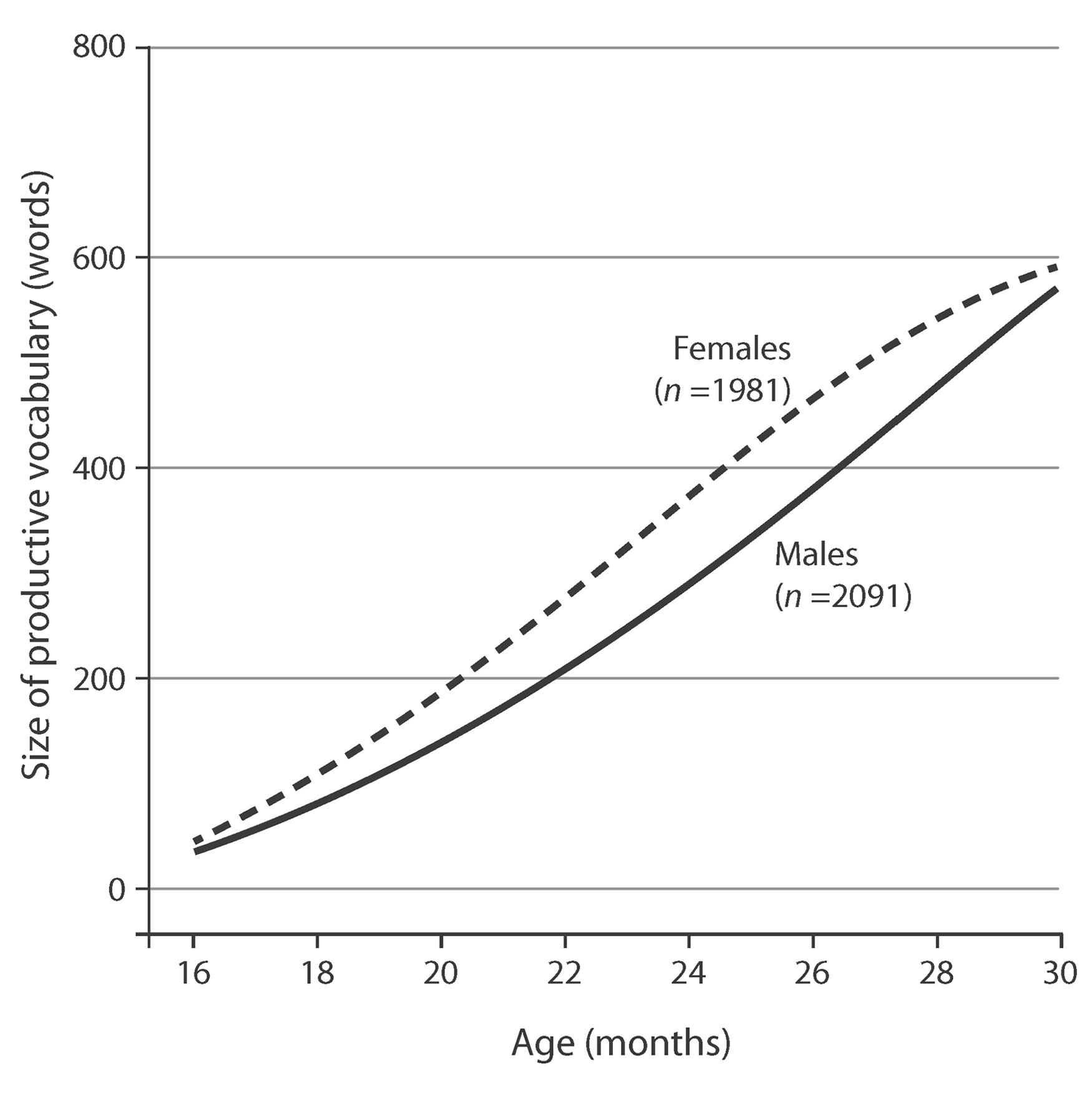
Figure 3.7. Average size of vocabulary produced by boys and girls between sixteen and thirty months of age
To give you an idea of what sex hormones like testosterone and estrogen can do to the developing brain, look what happens if you add extra estrogen to a key region in the mouse brain (see figure 3.8).

Figure 3.8. The effects of adding estrogen on neurons and their connections in the mouse brain. The brain region is called the sexually dimorphic nucleus of the preoptic area (SDN-POA). Left: no estrogen added. Right: estrogen added.
Given that some hyper-systemizers, like Jonah, are autistic, does how much testosterone a baby is exposed to in the womb predict how many autistic traits they will have as they grow up? We found that the higher a child’s prenatal testosterone, the more autistic traits they had.21 This was seen in the mother’s answers on a questionnaire measuring autistic traits in her toddler at eighteen months old, and again when her child was four years old. So how much you empathize, or how much you systemize, or how many autistic traits you have is influenced by how much prenatal testosterone you were exposed to in the womb.
To put this to the ultimate test, we conducted a study to find out if hyper-systemizers, like Jonah and other autistic children who struggle with empathy but who can be excellent systemizers, were exposed to elevated prenatal testosterone. We investigated this in the Danish Prenatal Testosterone Study, using the Biobank in Copenhagen, where obstetrician Bent Norgaard-Pedersen invited us to analyze the amniotic fluid from 20,000 samples he had carefully stored in his deep freezer since the mid-1990s. We looked at samples from pregnancies where the baby later received a diagnosis of autism and compared them to pregnancies where the baby developed typically.
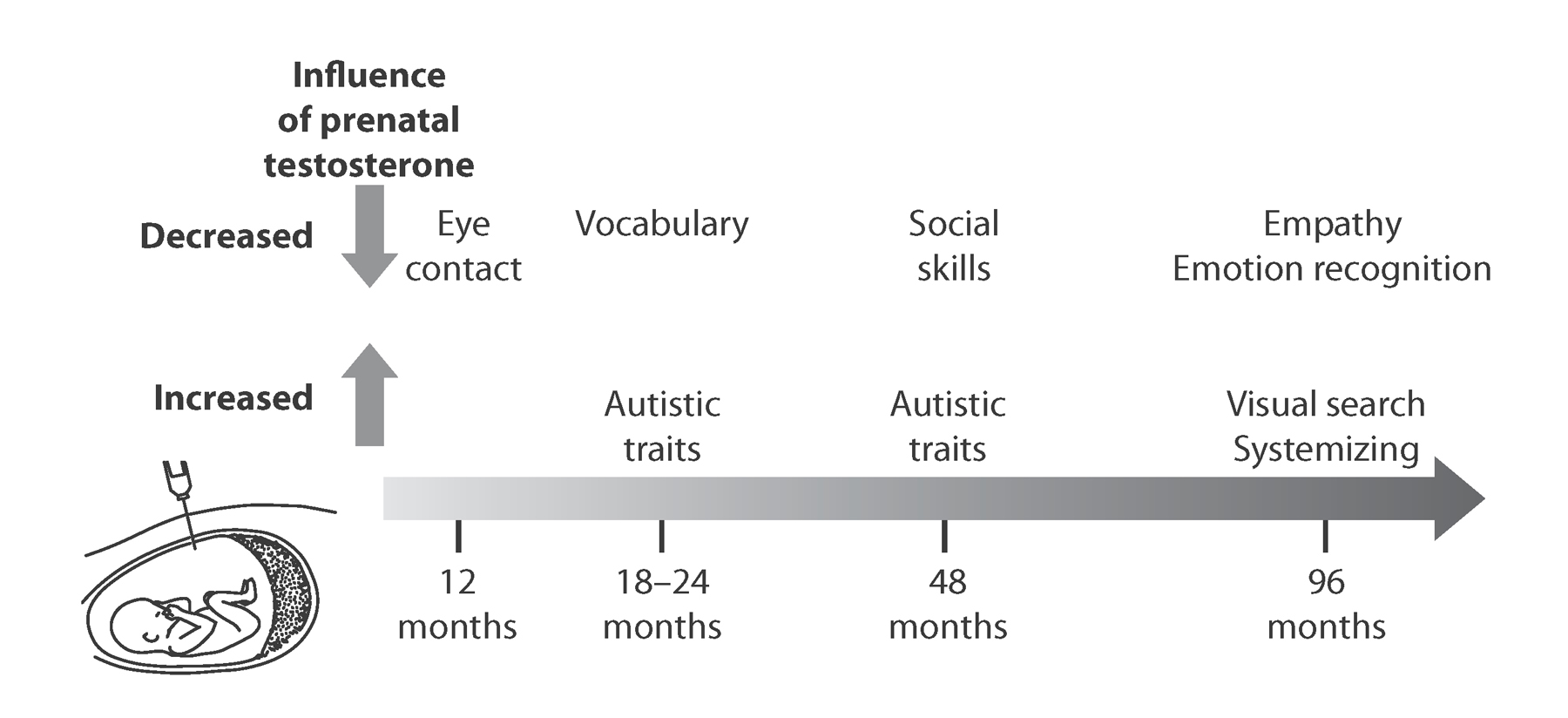
Figure 3.9. Higher prenatal exposure to testosterone is associated with both better systemizing and reduced empathy.
Sure enough, autistic children on average had higher levels of prenatal testosterone than typical kids. Interestingly, this also had knock-on effects for their levels of prenatal estrogens, which were also elevated on average in those who were later diagnosed as autistic, as would be expected, since testosterone is converted into estrogen.22 So, we had evidence that a biological factor—prenatal testosterone and estrogen—influences how much of an empathizer or a systemizer you are, and linking hyper-systemizers and autistic people at the hormonal level.

So much for prenatal hormones changing your brain, but can your genes change your brain too?
Many people would shudder at the idea that genes have anything to do with traits like systemizing or empathy, wanting to believe that all you need are the right learning opportunities and experiences. And they are partly right: learning and experience do count for something. But to claim that empathy and systemizing evolved, these psychological abilities must have had at least a partly genetic basis. To discover if genes play any part in empathy and systemizing we launched the ambitious Genetics of Empathizing and Systemizing Study.
Working with the personal genomics company 23andMe, we asked their customers—who consent to their genetic data being shared anonymously with researchers—to take two empathy tests so we could look for genetic associations with individual differences in scores on the empathy tests. Eighty-eight thousand people who had provided their DNA took one of our empathy tests, the “Reading the Mind in the Eyes” test, or the “Eyes” test for short.23 Of these, 46,000 also took the other empathy test, the Empathy Quotient (EQ), and 50,000 took the Systemizing Quotient (SQ).
On the Eyes test, volunteers are shown photos of the eye region of the face of different actors, each with a different emotional expression, and are asked to choose which of four words best describes what the actor is thinking or feeling. The test assesses how well you can imagine the mind of another person. We then carried out an analysis across the genome. We were excited to discover that scores on this test were heritable (the heritability among twins was 28 percent).24 This was sufficient to prove that empathy or theory of mind is partly under genetic control. And what’s more, we found that a sequence in one gene on chromosome 3 is associated with how well women perform on this test. So, while how much empathy you have is of course in part the result of your social experience, genes also play a role.
To be doubly sure about this conclusion, we looked at the DNA of the 46,000 individuals who had taken the EQ. Again, we carried out an analysis across the genome. Once again, we found that a common genetic variant is associated with how they scored on the EQ, and that some of the variation on the EQ could be explained by common genetic variants.25 Finding a genetic association with scores on empathy tests means that empathy evolved and could have been subject to selection pressure. (Selection pressure is where some individuals have a better chance of surviving to pass on their genes, giving rise to evolution.)

Figure 3.10. An item from the “Reading the Mind in the Eyes” test. Which of these four words best describes what the person in the photo is thinking or feeling? The correct answer here is “dispirited”—she’s a little bit sad.
We then turned to systemizing to find out if that is also partly genetic. This time we looked at the 50,000 people who had been genotyped and who had taken the Systemizing Quotient. Excitingly, we found that some of the variation on the SQ could be explained by common genetic variants, and that common variants in three genes were associated with systemizing, independent of other factors.26 So while the strength of your interest in systemizing is of course influenced by environmental factors (such as whether you had a good science teacher, or a parent who inspired you to observe nature, encouraged you to experiment with fixing things, or provided mechanical toys for you), we had proven that how much you systemize is also partly in your DNA—and therefore could have been positively selected in human evolution.
Another way to test if a trait is partly genetic is to study twins: if identical twins are more similar than are non-identical twins in a certain trait, this is a clue that genes play a role. One measure of systemizing that has been studied in twins is what Nobel Prize–winning psychologist Herbert Simon calls “satisficing.”27 Most of us are “satisficers”: we use the first thing to hand that works well enough to solve a problem. We say to ourselves, “This is good enough,” and we aren’t perfectionist, just wanting to get the job done speedily. We cut corners. In contrast, strong systemizers (sometimes called “maximizers”) search for the optimal solution to each problem that arises, even if this takes forever.
Imagine if you had to do some sewing. Most of us will just rifle through the sewing box at home, looking for a needle that will do the job, and use that. That’s satisficing. But some people will know that the perfect needle for the particular kind of material is of a particular length, thickness, and eye size. They will keep searching in the sewing box until they find the exact needle they need, even if it takes hours. That’s maximizing. Maximizers are perfectionist because they want to optimize the system, in this case sewing. So they are hyper-systemizers. A study of twins scored people on a dimension from satisficers through to maximizers. Identical twins were more alike on this dimension than were non-identical twins. So where you fall on the systemizing bell curve is partly genetic.
This fits with the results of the Genetics of Empathizing and Systemizing Study, where we found the common genetic variants associated with systemizing and empathy were independent of one another. This proves that the Empathy Circuit and the Systemizing Mechanism are under separate genetic influence.
What about the link between hyper-systemizing and autism? We saw that this link has a hormonal basis in the womb, but is this link also partly genetic? We know autism is partly
genetic, for three reasons: First, while only 1 to 2 percent of the population has a formal diagnosis of autism, a younger child in a family with an older sibling diagnosed as autistic has a 10 to 20 percent likelihood of also being autistic.28 Second, where one of a pair of twins is autistic, the other twin is more likely to be autistic too if he or she is an identical, rather than a non-identical, twin. Finally, there are more than one hundred rare genetic variants or mutations that have been linked to autism.29
As part of the Autism and Math Study, we asked math students at Cambridge University (who can be assumed to be strong systemizers), “Do you have a sibling who is autistic?” We found that the autism rate among the siblings of math students was higher than the autism rate among the siblings of students in the humanities.30 This hints at a shared genetic basis for autism and systemizing, since siblings on average share 50 percent of their genes.
Rare genetic mutations have only been found in fewer than 5 percent of autistic people, so the genetic basis of autism in the other 95 percent of autistic people is likely to lie in common variants that we all carry but that occur in specific combinations in autism. We tested if the known common genetic variants for autism overlap with those associated with systemizing. Among the 50,000 people who took the Systemizing Quotient, we found that 26 percent of the common genetic variants associated with a high score on the SQ correlated positively with the common genetic variants associated with autism. This was enough to prove that hyper-systemizing and autism share a genetic source. Expressed differently, some of the genes for hyper-systemizing and some of the genes for autism are the very same genes.
If you are someone who scores extremely high on the SQ and extremely low on the EQ, and so have an Extreme Type S brain type—that is, if you’re a hyper-systemizer—this means you think differently compared to most people. That’s because your mind, in common with most autistic people, has a different operating system. Less focused on people and more focused on things and on patterns, your operating system struggles to function in some environments but in others it may confer what autistic climate activist Greta Thunberg calls “superpowers”: a talent at spotting if-and-then patterns, just like Jonah did as a child.31
